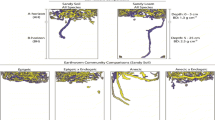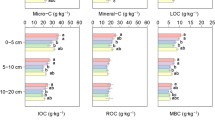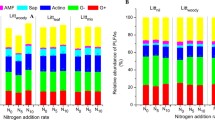Abstract
The important role of soil carbon (C) in the global C cycle has stimulated interest in better understanding the mechanisms regulating soil C storage and its stabilization. Exotic earthworm invasion of northern forest soils in North America can affect soil C pools, and we examined their effects on these mechanisms by adding 13C labeled leaf litter to adjacent northern hardwood forests with and without earthworms. Two types of labeled litter were produced, one with the 13C more concentrated in structural (S) components and the other in non-structural (NS) components, to evaluate the role of biochemical differences in soil C stabilization. Earthworm invasions have reduced soil C storage in the upper 20 cm of the soil profile by 37 %, mostly by eliminating surface organic horizons. Despite rapid mixing of litter into mineral soil and its incorporation into aggregates, mineral soil C has not increased in the presence of earthworms. Incorporation of litter C into soil and microbial biomass was not affected by biochemical differences between S versus NS labeled litter although NS litter C was assimilated more readily into earthworm biomass and S litter C into fungal hyphae. Apparently, the net effect of earthworm mixing of litter and forest floor C into mineral soil, plus stabilization of that C in aggregates, is counterbalanced by earthworm bioturbation and possible priming effects. Our results support recent arguments that biochemical recalcitrance is not a major contributor to the stabilization of soil C.





Similar content being viewed by others
References
Addison JM (2009) Distribution and impacts of invasive earthworms in Canadian forest ecosystems. Biol Invasions 11:59–79
Alban DH, Berry EC (1994) Effects of earthworm invasion on morphology, carbon, and nitrogen of a forest soil. Appl Soil Ecol 1:243–249
Bohlen PJ, Pelletier DM, Groffman PM, Fahey TJ, Fisk MC (2004a) Influence of earthworm invasion on redistribution and retention of soil carbon and nitrogen in northern temperate forests. Ecosystems 7:28–44
Bohlen PJ, Groffman PM, Fahey TJ, Fisk MC (2004b) Ecosystem consequences of exotic earthworm invasion of north temperate forests. Ecosystems 7:1–13
Bossuyt H, Six J, Hendrix PF (2005) Protection of soil carbon by microaggregates within earthworm casts. Soil Biol Biochem 37:251–258
DeGryze R, Six J, Merckx R (2006) Quantifying water-stable soil aggregate turnover and its implication to soil organic matter dynamics in a model study. Eur J Soil Sci 57:693–707
Don A, Steinberg B, Schöning I, Pritsch K, Joschko M, Gleixner G, Schulze ED (2008) Organic carbon sequestration in earthworm burrows. Soil Biol Biochem 40:1803–1812
Dungait JAJ, Hopkins DW, Gregory AS, Whitmore AP (2012) Soil organic matter turnover is governed by accessibility not recalcitrance. Glob Change Biol 18:1781–1796
Easter M, Paustian K, Killian K, Williams S, Feng T et al (2007) The GEFSOC soil carbon modelling system: A tool for conducting regional-scale soil carbon inventories and assessing the impacts of land use change on soil carbon. Agric Ecosyst Environ 122:13–25
Edwards CA (2004) Earthworm Ecology. CRC Press, Boca Raton
Edwards CA, Bohlen PJ (1996) Biology and Ecology of Earthworms. Chapman and Hall, New York
Eisenhauer N, Partsch S, Parkinson D, Scheu S (2007) Invasion of a deciduous forest by earthworms: changes in soil chemistry, microflora, microarthropods and vegetation. Soil Biol Biochem 39:1099–1110
Fahey TJ, Yavitt JB, Sherman RE, Groffman PM, Fisk MC, Maerz JC (2011) Transport of carbon and nitrogen between litter and soil organic matter in a northern hardwood forest. Ecosystems 14:326–340
Fain JJ, Volk TA, Fahey TJ (1994) Fifty years of change in an upland forest in south-central New York: general patterns. Bull Torrey Bot Club 121(2):130–139
Filley TR, McCormick MK, Crow SE, Szlavecz KE, Whigham DF, Johnston CT, van den Heuvel R (2008) Comparison of the chemical alteration trajectory of Liriodendron tulipifera L. leaf litter among forests with different earthworm abundance. J Geophys Res Biogeosci 113:G01027. doi:10.1029/2007JG000542.Research: Biogeosciences, 113 Issue: G3: G03009
Fitter AH, Gilligan CA, Hollingworth K, Kleczkowski A, Twyman RM, Pitchford JW (2005) Biodiversity and ecosystem function in soil. Funct Ecol 19:367–377
Fonte SJ, Kong AYY, vanKessel C, Hendrix PF, Six J (2007) Influence of earthworm activity on aggregate-associated carbon and nitrogen dynamics differs with agroecosystem management. Soil Biol Biochem 39:1014–1022
Guggenberger G, Kaiser K (2003) Dissolved organic matter in soil: challenging the paradigm of sorptive preservation. Geoderma 113:293–310
Hale CM, Frelich LE, Reich PB, Pastor J (2005) Effects of European earthworm invasion on soil characteristics in northern hardwood forests of Minnesota, USA. Ecosystems 8:911–927
Harris D, Voroney RP, Paul EAL (1997) Measurement of microbial biomass N:C by chloroform fumigation-incubation. Can J Soil Sci 77:507–514
Hendrix PF, Callaham MA Jr, Drake JM, Huang C-Y, James SW, Snyder BA, Zhang W (2008) Pandora’s Box contained bait: the global problem of introduced earthworms. Annu Rev Ecol Evol Syst 39:593–613
Hong et al (2011) How do earthworms influence organic matter quantity and quality in tropical soils? Soil Biol Biochem 43:223–230
Horowitz ME, Fahey TJ, Yavitt JB, Feldpausch TR, Sherman RE (2009) Patterns of late-season photosynthate movement in sugar maple (Acer saccharum Marsh) saplings. Can J For Res 39:2294–2298
Huang CY, Hendrix PF, Fahey TJ, Bohlen PJ, Groffman PM (2010) A simulation model to evaluate the impacts of invasive earthworms on soil carbon dynamics. Ecol Model 221:2447–2457
James SW (1995) Systematics, biogeography, and ecology of neartic earthworms from eastern, central, southern, and southwestern United States. In: Hendrix PF (ed) Earthworm ecology and biogeography in North America. Lewis, Boca Raton, pp 29–52
Jandl R, Lindner M, Bauwens L, Baritz R, Hagedom F, Johnson DW, Minkkinen K, Byrne KA (2007) How strongly can forest management influence soil carbon sequestration? Geoderma 137:253–268
Jenkinson DS, Powlson DS (1976) The effects of biocidal treatments on metabolism in soil. V. A method for measuring soil biomass. Soil Biol Biochem 8:209–213
Kaiser K, Guggenberger G, Zech W (1996) Sorption of DOM and DOM fractions to forest soils. Geoderma 74:281–303
Kleber M (2010) What is recalcitrant soil organic matter? Environ Chem 7:320–332
Kleber M, Johnson MG (2010) Advances in understanding the molecular structure of soil organic matter: implications for interactions in the environment. Adv Agron 106:77–142
Lal R (2004) Soil carbon sequestration impacts on global climate change and food security. Science 304:1623–1627
Lavelle P, Pashanasi B, Charpentier F, Gilot C, Rossi JP, Derouard L, Andre J, Ponge JF, Bernier N (1998) Large-scale effects of earthworms on soil organic matter and nutrient dynamics. In: Edwards CA (ed) Earthworm Ecology. St. Lucie Press, Boca Raton, pp 103–122
Lawrence AP, Bowers MA (2002) A test of the “hot” mustard extraction method of sampling earthworms. Soil Biol Biochem 34:549–552
Li X, Fisk MC, Fahey TJ (2002) Influence of earthworm invasion on soil microbial biomass and activity in a northern hardwood forest. Soil Biol Biochem 34:1929–1937
Mambelli S, Bird JA, Gleixner G, Dawson TE, Torn MS (2011) Relative contribution of foliar and fine root pine litter to the molecular composition of soil organic matter after in situ degradation. Org Geochem 42:1099–1108
McLean MA, Parkinson D (1997) Changes in structure, organic matter and microbial activity in pine forest soil following introduction of Dendrobaena oetaedra (Oligochaeta, Lumbricidae). Soil Biol Biochem 29:637–640
McLeod AR, Newsham KK, Fry SC (2007) Elevated UV-B radiation modifies carbohydrate availability from leaf litter of Quercus robur. Soil Biol Biochem 39:116–126
Nadelhoffer KJ, Fry B (1994) Nitrogen isotope studies in forest ecosystems. In: Lajtha K, Michener RH (eds) Stable isotopes in ecology and environmental science. Blackwell, Oxford, pp 22–44
Paterson E, Oster G, Dawson LA, Gebbing T, Sim A, Ord B (2008) Labile and recalcitrant plant fractions are utilized by distinct microbial communities in soil: independent of the presence of roots and mycorrhizal fungi. Soil Biol Biochem 40:1103–1113
Popper ZA, Fry SC (2005) Widespread occurrence of a covalent linkage between xyloglucan and acidic polysaccharides in suspension-cultured angiosperm cells. Ann Bot 96:91–99
Post WM, Emanuel WR, Zinke PJ, Stangenberger AG (1982) Soil carbon pools and world life zones. Nature 298:156–159
Qualls R, Haines BL (1992) Biodegradability of dissolved organic matter in forest throughfall, soil solution, and stream water. Soil Sci Soc Am J 56:578–586
Rasse DP, Rumpel C, Dignac MF (2005) Is soil carbon mostly root carbon? Mechanisms for a specific stabilization. Plant Soil 269:341–356. doi:10.1007/s11104-004-0907-y
Rowell DL (1994) Soil science: methods and applications. Longman, London
Schmidt MWI, Torn MS, Abiven S, Dittmar T et al (2011) Persistence of soil organic matter as an ecosystem property. Nature 478:49–56
Simpson AJ, Simpson MJ, Smith E, Kelleher BP (2007) Microbially-derived inputs to soil organic matter: are current estimates too low? Environ Sci Technol 41:8070–8076
Six J, Elliot ET, Paustian K (2000) Soil macroaggregate turnover and microaggregate formation: a mechanism for C sequestration under no-tillage agriculture. Soil Biol Biochem 32:2099–2103
Six J, Conant RT, Paul EA, Paustian K (2002) Stabilization mechanisms of soil organic matter: implications for C-saturation of soils. Plant Soil 241:155–176
Sollins P, Swanston C, Kleber M, Filley T, Kramer MG, Crow S, Caldwell B, Lajtha K, Bowden R (2006) Organic C and N stabilization in a forest soil: evidence from sequential density fractionation. Soil Biol Biochem 38:3313–3324
Stoscheck LM, Sherman RE, Suarez ER, Fahey TJ (2012) Exotic earthworm distributions did not expand over a decade in a hardwood forest in New York state. Appl Soil Ecol 62:124–130. doi:10.1016/j.apsoil.2012.07.002
Suarez ER, Tierney GL, Fahey TJ, Fahey R (2006a) Exploring patterns of exotic earthworm distribution in a temperate hardwood forest in south-central New York, USA. Landsc Ecol 21:297–306
Suarez ER, Fahey TJ, Groffman PM, Yavitt JB, Bohlen PJ (2006b) Spatial and temporal dynamics of exotic earthworm communities along invasion fronts in a temperate hardwood forest in South-Central New York (USA). Biol Invasions 8(4):553–564
Swift MJ, Heal OW, Anderson JM (1979) Decomposition in Terrestrial Ecosystems. Blackwell Scientific Publications, Oxford
Tisdall JM, Oades JM (1982) Organic matter and waterstable aggregates in soil. J Soil Sci 33:141–163
Wallander H, Nilsson LA, Hagerberg D, Bååth E (2001) Estimation of the biomass and seasonal growth of external mycelium of ectomycorrhizal fungi in the field. New Phytol 151:753–760
Wironen M, Moore TR (2006) Exotic earthworm invasion increases soil carbon and nitrogen in an old-growth forest in southern Quebec. Can J For Res 36:845–854
Acknowledgments
For assistance in the field and laboratory, the authors thank J. Beem-Miller, F. Chen, M. Dempsey, T. Feldpausch, L. Martel, J. Milanovich, R. Schmidt, M. Spigler and L. Stoschek. This research was supported by a Grant from the Ecosystem Studies Program, National Science Foundation.
Author information
Authors and Affiliations
Corresponding author
Rights and permissions
About this article
Cite this article
Fahey, T.J., Yavitt, J.B., Sherman, R.E. et al. Earthworms, litter and soil carbon in a northern hardwood forest. Biogeochemistry 114, 269–280 (2013). https://doi.org/10.1007/s10533-012-9808-y
Received:
Accepted:
Published:
Issue Date:
DOI: https://doi.org/10.1007/s10533-012-9808-y




